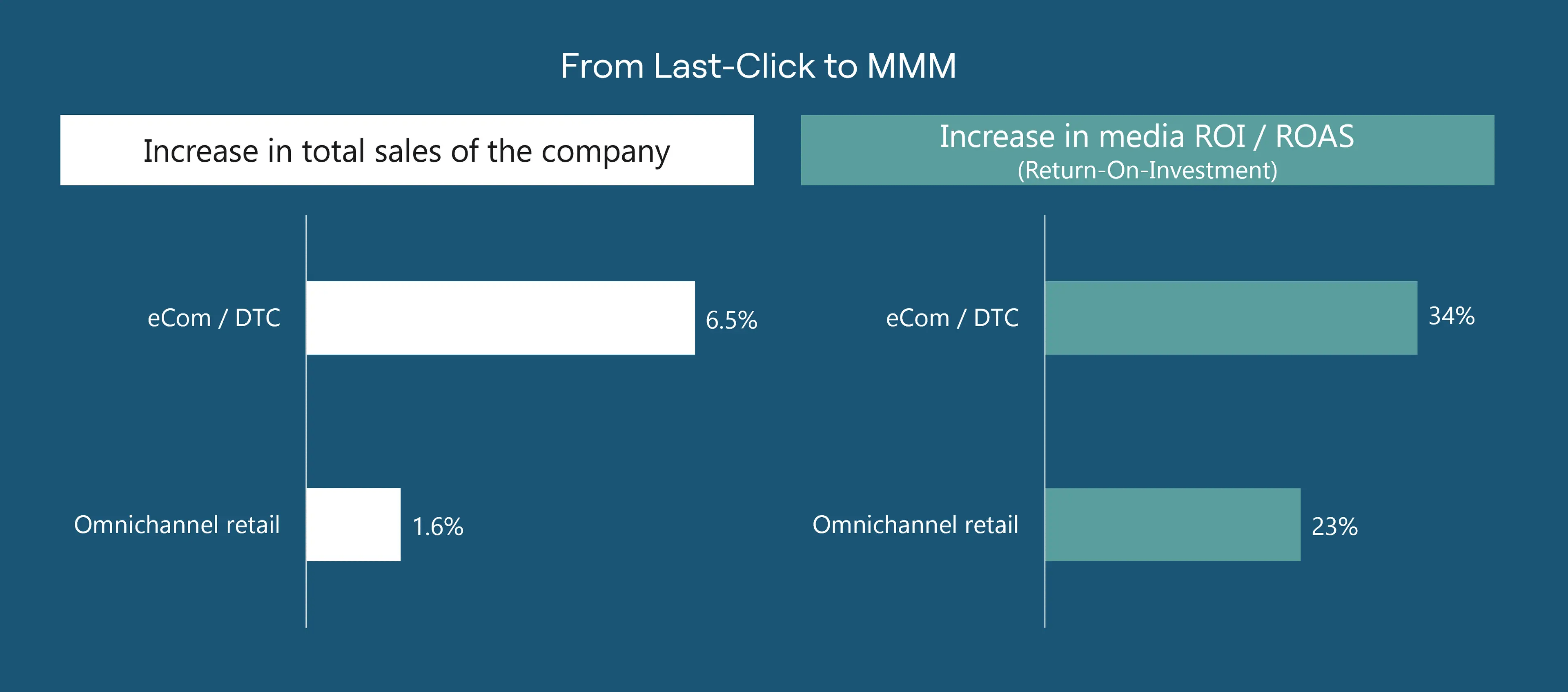Unlock 6.5% More Sales with Marketing Mix Modeling

For years, performance marketing teams have relied on last-click attribution as their go-to method for optimizing advertising spend across ad platforms, channels, and campaigns. While its limitations become increasingly evident (see e.g. How to measure Meta correctly?), too many advertisers still default to last-click-based optimization, unaware of the revenue they’re leaving on the table. Meanwhile, their competitors are pulling ahead by embracing Marketing Mix Modeling (MMM), an approach that, unlike last-click, can measure the true incremental sales impact of media.
In this article, we set out to quantify exactly how much more sales advertisers could unlock by switching from last-click to MMM. The results might surprise you.
Unlocking +6.5% More Sales with MMM
Analyzing a sample of 27 eCommerce/DTC advertisers, we found that switching from last-click to Marketing Mix Modeling (MMM) drives a +6.5% increase in sales — without increasing total media spend.
For an eCom/DTC business with $21M of annual revenue (median in the sample), this translates to a $1.4M revenue increase. For digital marketers focused on ROI, this means a +34% increase in ROI / ROAS.
To quantify this impact, we implemented MMM for each eCom / DTC business, who didn't have MMM in use, and leveraged Sellforte’s optimization tools to assess the full potential of MMM-based recommendations.

Sales impact of transitioning from Last-Click to MMM
Similarly, for 10 omnichannel retailers operating both online and offline, our analysis revealed that MMM delivers at least a 1.6% increase in total sales (with the same media budget), which translates to a $19M annual sales increase if you are a $1.2B retailer (median in the sample).
What Are the Optimization Levers in MMM?
The picture below presents a breakdown of the three optimization drivers behind the 6.5% identified sales increase opportunity for eCommerce and Direct-to-Consumer (DTC) businesses. The sales increase opportunity was identified for the same media budget, and the impact of each lever is the median in the study.

Typical drivers of media spend optimization eCom / DTC (medians in the study)
For Retailers, the identified 1.6% revenue increase from adopting MMM splits evenly between levers (2) and (3), each driving a 0.8% increase in annual revenue. In Retail, we lacked sufficient n for quantifying the impact of campaign optimization in this research, meaning that full impact of MMM is somewhat higher than 1.6%.
Next, we will look at each lever one by one.
1) Optimize budget allocation across campaigns: +2.9% sales for eCom/DTC
Many marketers might not immediately associate Marketing Mix Modeling (MMM) with campaign-level optimization, assuming MMM is only useful for high-level budget allocation. However, modern MMM solutions have evolved, and most powerful MMMs today offer campaign-level optimization to drive growth. In fact, eCom/DTC brands can unlock 2.9% additional sales by reallocating budgets across campaigns based on MMM insights.
Digital marketers spend countless hours analyzing campaign performance and adjusting budgets, traditionally relying on ROAS and other metrics from ad platform attribution or last-click attribution in Google Analytics 4 (GA4). The problem? These methods fail to measure the true incremental impact of each campaign, often leading to suboptimal budget allocation. For example, GA4’s last-click model is notorious for undervaluing social media channels, which can mislead marketers into underinvesting in highly effective campaigns.
Modern MMM solutions, on the other hand, can estimate each campaign’s true ROI based on the true incremental sales impact of each campaign. This helps advertisers shift budgets toward the most effective campaigns, rather than just those that appear to perform well in last-click reports. This shift alone accounts for the 2.9% increase in total sales seen in the study.
As an example, below is a screenshot from campaign-view of Sellforte’s eCom demo ( https://demo.sellforte.com/), which shows:
- True ROI estimated by MMM (and comparison to GA4’s ROAS and ad platform -reported ROAS).
- Recommended percentage change to each campaign (recommendation in this case is based on keeping the total budget same).

Sellforte Campaign dashboard
2) Optimize budget allocation across advertising channels: +1.6% sales for eCom/DTC
The most known MMM use-case is optimizing media allocation across advertising channels. In our terminology, “advertising channel” refers to the level that is one click deeper within ad platforms. For example, we group Meta campaigns into Prospecting, Retargeting, Awareness, Sales, Advantage+ and so on, and Google Ads campaigns into Performance Max, branded search, non-branded search, display, shopping and so on. Some also refer to these as “tactics”.

Illustration of re-allocation media budget by advertising channnel
Despite being the most common use-case, this is the smallest out of the three levers in this research. The +1.6% revenue increase opportunity for eCom / DTC businesses comes from decreasing or stopping channels with poor performance or high level of saturation and shifting spend to channels which have room to scale.
When transitioning from last-click to MMM, the most typical spend shift happens from bottom-of-funnel channels, that are over-estimated by last-click, to mid- or top-of-funnel channels, whose effectiveness is under-measured by click-based attribution.
Research note: Campaign-optimization and channel-optimization have an overlap, when spend is shifted from a campaign in one channel to a campaign in another channel. In this research we quantified the overlap separately and removed it from the sales improvement potential by allocating its effect with 50/50 split to campaign/channel optimization.
3) Optimize budget pacing throughout the year: +2.0% sales for eCom/DTC
The third optimization lever, budget pacing, ensures that advertising spend is distributed optimally across weeks, preventing for example overinvestment when demand is naturally low and underinvestment when there’s high level natural demand. Below is an illustration of what optimization outlook can look like for this lever:

Illustration of optimizing budget pacing with Marketing Mix Modeling
For many advertisers still using attribution-based optimization, budget pacing is often an overlooked area for improvement. This is because there’s no universally correct spend pacing across weeks — every company has unique seasonality patterns, promotional cycles, and demand fluctuations. For instance, a common mistake we see is overinvesting during slow seasons while underfunding critical sales periods like Black Friday.
When executed correctly, budget pacing can unlock a +2.0% increase in annual sales for eCom / DTC businesses, making it a powerful yet underutilized growth driver.
Why Last-Click Fails Marketers in Optimization
When it comes to media budget allocation, last-click falls short in two critical areas: 1) Not able to measure incrementality, a requirement for accurate ROI measurement, 2) Lack of response curves to understand saturation levels.
Last-click Not Able to Measure Incrementality
Last-click is unable to measure the true incremental sales impact of each channel, leading to inaccurate measurement of ROI. Sometimes last-click attributes too many conversions to a channel, like in the case of branded search, whereas sometimes it massively underreports ROI of a channel, like it often does for social media channels.
To illustrate how significant the accuracy challenge is, let's use the example in the graph below, which is from our earlier research how accurately Last-Click measures Meta channels. The research shows that effectiveness of Meta Advantage+ in driving eCommerce sales is typically 4x compared to what last-click reports. If you're a retailer with offline sales, you still need to multiply this by 1.7x to also capture the offline sales impact of Advantage+. This means that true ROI of Meta Advantage+ can be 6.8x compared to what last-click is reporting.

Illustration: Measuring the full impact of Meta Advantage+ with MMM
Last-click Lacks Response Curves
Last-click lacks response curves to understand media saturation levels. One of the superpowers of Marketing Mix Modeling, is the ability to understand the level of saturation of each channel with response curves. This is the foundation for MMM based optimization: spend is decreased from saturated channels, and re-invested to channels with room to scale.
As an example, let's look at the graph below, representing a response curve for one channel. If you are in Point B, it's not a good idea to invest more, but if you are in Point A, you have lots of room for scaling. Read more from our in-depth article on Response Curves.

Example of a response curve showing different levels of saturation
Conclusions
For ambitious brands, MMM is not just about understanding your media investments' ROI – it’s about continuous optimization of advertising spend allocation to get the most out of every dollar spent.
Agile media investment optimization unlocks massive sales uplift potential and considering the ease of implementing one today, it might be the most effective marketing hack at the moment.
Curious to learn more? Start a Free Trial or Book a Demo.
Research details
How was the study conducted? Each company in the study was onboarded to Sellforte’s MMM, and Sellforte’s optimization and scenario planning features was used to identify the full potential. Optimization tools leverage key MMM outputs, such as response curves.
What does the “improvement potential” identified in the study mean? The identified improvement potential is the full potential that can be achieved by transitioning from pre-Sellforte optimization practices (which is dominated by last-click for digital media), to optimizing budget allocation with Marketing Mix Modeling (MMM) -based insights. The full potential was identified by keeping the total media budget the same.
Further reading
- What is Marketing Mix Modeling (MMM)? A Complete Guide. Link
- How to measure Meta correctly? GA4 vs. MTA vs. MMM. Link
- How to measure Meta correctly? Part 2: Add offline sales impact. Link
- Advertising response curves: What are they and why do you need them? Link
- Calibrating Marketing Mix Models with Experiments and Attribution data. Link
- 23 Marketing Mix Modeling Tools for Accelerating Growth in 2025. Link
- How Much Ad Spend Is Needed for Marketing Mix Modeling? Link

You May Also Like
These Related Stories
